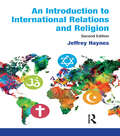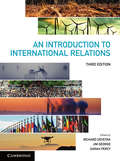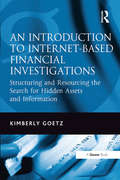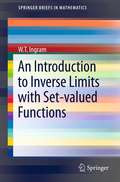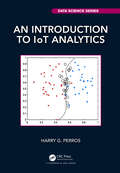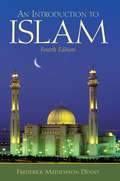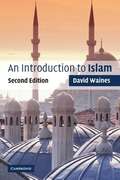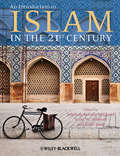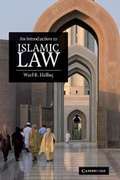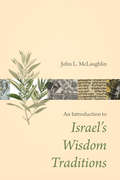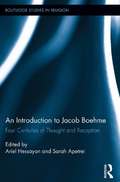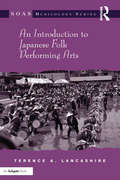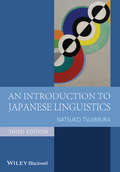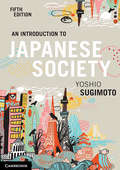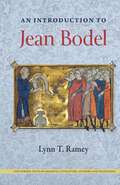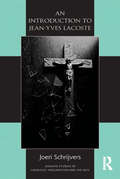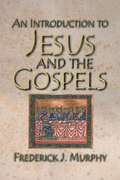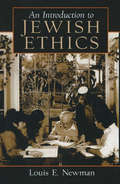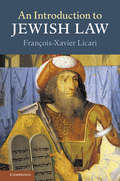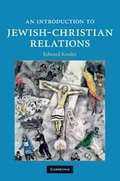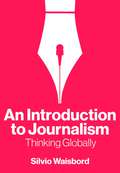- Table View
- List View
An Introduction to International Relations and Religion
by Jeffrey HaynesNot so very long ago it seemed reasonable to assert that the influence of religion on global politics was on the wane. As the Western world became increasingly secular and the process of globalisation deepened, it seemed inevitable - on the surface at least - that the voice of religion was to be heard softly if it was to be heard at all. This has now changed, and changed perhaps irrevocably. As Jeff Haynes argues in this thought-provoking and important new book, various religious 'actors' are now significantly involved in international relations and have become a crucial influence on policy in a post-Westphalian world. International Relations and Religion guides the reader through the complex issues at the heart of this topic with clarity and insight. This updated second edition starts with a close reading of the many theoretical and analytical concepts - notably Huntington and the clash of civilisations - that have grown up around this area and then concludes with a summary of the issues under discussion and attempts to put into context what it means to live in a world that is increasingly shaped by a whole host of diverse religious groups. Essential reading for students of International Relations and Politics.
An Introduction to International Relations: Australian Perspectives (Critical Perspectives On World Politics Ser.)
by Richard Devetak Jim George Sarah PercyAn Introduction to International Relations is a comprehensive introduction to the history, theories, developments and debates that shape the dynamic discipline of international relations and contemporary world politics. Bringing together an expert author team comprising leading academics from Australia and around the world, it allows readers to explore the discipline from both Australian and global perspectives. Known for its clear, easy-to-read style and relevant, real-world examples, the text has been fully updated and revised to reflect current research and the changing global political climate. This edition features extensive new material on: international history from World War I to World War II; international law; the globalisation of international society; and terrorism. A companion website for instructors offers additional case studies, critical thinking questions and links to relevant video and web materials that bring international relations theory to life.
An Introduction to Internet-Based Financial Investigations: Structuring and Resourcing the Search for Hidden Assets and Information
by Kimberly GoetzIncreasingly, employees of regulatory bodies, law enforcement agencies and others who are not trained forensic accountants or experienced investigators find themselves responsible for conducting what amount to financial investigations. An engineer who oversees the cleanup of a toxic waste site might need to track down the former owners of the site to find the polluter. Perhaps the applicable licensing agency receives a complaint that an attorney mishandled a client's money. Maybe it's the attorney who needs help finding the assets with which a client's former spouse has absconded. Training in investigation techniques tends to be very limited for many employees. Training on how to find information without incurring significant expense is virtually nonexistent. This book helps fill the void. An Introduction to Internet-Based Financial Investigations will help anyone who conducts financial investigations as part of their job to reduce their dependence on trial and error by showing them where and how to look. Using clear sections describing how to approach an investigation, including the ethical perspective; what to look for and what you find; what free and low cost internet resources are available to support investigations; and how to assemble and present the results of investigations, Kimberly Goetz guides students and beginning investigators through the complex world of financial investigations.
An Introduction to Inverse Limits with Set-valued Functions (SpringerBriefs in Mathematics)
by W. T. IngramInverse limits with set-valued functions are quickly becoming a popular topic of research due to their potential applications in dynamical systems and economics. This brief provides a concise introduction dedicated specifically to such inverse limits. The theory is presented along with detailed examples which form the distinguishing feature of this work. The major differences between the theory of inverse limits with mappings and the theory with set-valued functions are featured prominently in this book in a positive light. The reader is assumed to have taken a senior level course in analysis and a basic course in topology. Advanced undergraduate and graduate students, and researchers working in this area will find this brief useful.
An Introduction to IoT Analytics (Chapman & Hall/CRC Data Science Series)
by Harry G. PerrosThis book covers techniques that can be used to analyze data from IoT sensors and addresses questions regarding the performance of an IoT system. It strikes a balance between practice and theory so one can learn how to apply these tools in practice with a good understanding of their inner workings. This is an introductory book for readers who have no familiarity with these techniques. The techniques presented in An Introduction to IoT Analytics come from the areas of machine learning, statistics, and operations research. Machine learning techniques are described that can be used to analyze IoT data generated from sensors for clustering, classification, and regression. The statistical techniques described can be used to carry out regression and forecasting of IoT sensor data and dimensionality reduction of data sets. Operations research is concerned with the performance of an IoT system by constructing a model of the system under study and then carrying out a what-if analysis. The book also describes simulation techniques. Key Features IoT analytics is not just machine learning but also involves other tools, such as forecasting and simulation techniques. Many diagrams and examples are given throughout the book to fully explain the material presented. Each chapter concludes with a project designed to help readers better understand the techniques described. The material in this book has been class tested over several semesters. Practice exercises are included with solutions provided online at www.routledge.com/9780367686314 Harry G. Perros is a Professor of Computer Science at North Carolina State University, an Alumni Distinguished Graduate Professor, and an IEEE Fellow. He has published extensively in the area of performance modeling of computer and communication systems.
An Introduction to Islam
by David WainesIslam is a world-wide religion embracing many cultures and nations, comprising today nearly 900 million people. Muslims believe that God (Allah) revealed to the Prophet Muhammad guidance for proper conduct in this world and salvation in the next. These revelations are contained in the Muslims' scripture, the Qur'an. From modest beginnings in Mecca fourteen centuries ago, Islam spread rapidly throughout the Middle East and then into south-east Asia. This book is the story of the Muslims' beliefs and practices as they developed during the formative period. Separate chapters are devoted to a description of the sacred law (the Shar'iah), theology, and mysticism. Attention is given also to the beliefs and practices of the important Shi'ah minority of Muslims. The story comes down to the present day, recounting the period over the last two centuries during which Muslims have been challenged by Western hegemony and have sought to establish a modern sense of identity.
An Introduction to Islam
by Frederick DennyAn Introduction to Islam, Fourth Edition, provides students with a thorough, unified and topical introduction to the global religious community of Islam. In addition, the author's extensive field work, experience, and scholarship combined with his engaging writing style and passion for the subject also sets his text apart. An Introduction to Islam places Islam within a cultural, political, social, and religious context, and examines its connections with Judeo-Christian morals. Its integration of the doctrinal and devotional elements of Islam enables readers to see how Muslims think and live, engendering understanding and breaking down stereotypes. This text also reviews pre-Islamic history, so readers can see how Islam developed historically.
An Introduction to Islam (Second Edition)
by David WainesThis wide-ranging account of the history and theology of one of the world's most dynamic religions tells the story of Islamic beliefs and practices as they developed from the earliest times down to the present day. For this revised and updated Second Edition, David Waines has added a long section tackling head-on the issues arising from Islam's place in the changing world order at the turn of the new millennium. The wars in Bosnia, Afghanistan and Israel, and the terrorist attacks on New York and Washington, have raised global awareness of Islam at a superficial level - but little has been written which considers Islamic political and military extremism in relation to mainstream Muslim history and theology. Coming at the end of a book which has explored the ideas and traditions of Islam in depth, this new section offers thought-provoking reflections on the place of religion in the current conflicts.
An Introduction to Islam in the 21st Century
by Aminah Beverly Mccloud Scott W. Hibbard Laith SaudThis engaging introduction to Islam examines its lived reality, its worldwide presence, and the variety of beliefs and practices encompassed by the religion. The global perspective uniquely captures the diversity of Islam expressed throughout different countries in the present day.A comprehensive, multi-disciplinary, and global introduction to Islam, covering its history as well as current issues, experiences, and challengesIncorporates key new research on Muslims from a variety of countries across Europe, Latin America, Indonesia, and Malaysia Central AsiaDirectly addresses controversial issues, including political violence and 'terrorism', anti-western sentiments, and IslamophobiaExplores different responses from various Islamic communities to globalizing trendsHighlights key patterns within Islamic history that shed light upon the origins and evolution of current movements and thought
An Introduction to Islamic Law
by Wael B. HallaqThe study of Islamic law can be a forbidding prospect for those entering the field for the first time. Wael Hallaq, a leading scholar and practitioner of Islamic law, guides students through the intricacies of the subject in this absorbing introduction. The first half of the book is devoted to a discussion of Islamic law in its pre-modern natural habitat. The second part explains how the law was transformed and ultimately dismantled during the colonial period. In the final chapters, the author charts recent developments and the struggles of the Islamists to negotiate changes which have seen the law emerge as a primarily textual entity focused on fixed punishments and ritual requirements. The book, which includes a chronology, a glossary of key terms, and lists of further reading, will be the first stop for those who wish to understand the fundamentals of Islamic law, its practices and history.
An Introduction to Israel's Wisdom Traditions
by John L. McLaughlinIt can be a challenge to understand the Hebrew Bible’s wisdom literature and how it relates to biblical history and theology, but John L. McLaughlin makes this complicated genre straightforward and accessible.This introductory-level textbook begins by explaining the meaning of wisdom to the Israelites and surrounding cultures before moving into the conventions of the genre and its poetic forms. The heart of the book examines Proverbs, Job, Qoheleth (Ecclesiastes), and the deuterocanonical Ben Sira and Wisdom of Solomon. McLaughlin also explores the influence of wisdom throughout the Old Testament and in the New Testament.Designed especially for beginning students—and based on twenty-five years of teaching Israel’s wisdom literature to university students—McLaughlin’s Introduction to Israel’s Wisdom Traditions provides an informed, panoramic view of wisdom literature’s place in the biblical canon.
An Introduction to Jacob Boehme: Four Centuries of Thought and Reception (Routledge Studies in Religion)
by Ariel Hessayon Sarah ApetreiThis volume brings together for the first time some of the world’s leading authorities on the German mystic Jacob Boehme, to illuminate his thought and its reception over four centuries for the benefit of students and advanced scholars alike. Boehme’s theosophical works have influenced Western culture in profound ways since their dissemination in the early 17th Century, and these interdisciplinary essays trace the social and cultural networks as well as the intellectual pathways involved in Boehme’s enduring impact. The chapters range from situating Boehme in the 16th Century Radical Reformation, to discussions of his significance in modern theology. They explore the major contexts for Boehme’s reception including the Pietist movement, Russian religious thought and Western esotericism, as well as focusing more closely on important readers: the religious radicals of the English Civil Wars and the later English Behmenists; literary figures such as Goethe and Blake, and great philosophers of the modern age, among them Schelling and Hegel. Together, the chapters illustrate the depth and variety of Boehme’s influence and a concluding chapter addresses directly an underlying theme of the volume – asking why Boehme matters today, and how readers in the present might be enriched by a fresh engagement with his apparently opaque and complex writings.
An Introduction to Japanese Folk Performing Arts (SOAS Studies in Music Series)
by Terence A. LancashireJapanese folk performing arts incorporate a body of entertainments that range from the ritual to the secular. They may be the ritual dances at Shinto shrines performed to summon and entertain deities; group dances to drive away disease-bearing spirits; or theatrical mime to portray the tenets of Buddhist teachings. These ritual entertainments can have histories of a thousand years or more and, with such histories, some have served as the inspiration for the urban entertainments of no, kabuki and bunraku puppetry. The flow of that inspiration, however, has not always been one way. Elements taken from these urban forms could also be used to enhance the appeal of ritual dance and drama. And, in time, these urban entertainments too came to be performed in rural or regional settings and today are similarly considered folk performing arts. Professor Terence Lancashire provides a valuable introductory guide to the major performance types as understood by Japanese scholars.
An Introduction to Japanese Kanji Calligraphy
by Bob Godin Takezaki KuniiThis step-by-step Japanese calligraphy book explains the systems of Japanese language and delves into details of written Japanese characters and techniques of kanji calligraphy.The word calligraphy literally means "beautiful writing." It is an art form that can be found in most civilizations with a written script. Originally developed to stress the importance of culture, religion and philosophy, over time calligraphy in most languages has developed into a purely artistic expression.In Japanese culture, kanji characters from the Japanese writing system are used in calligraphy. An Introduction to Japanese Kanji Calligraphy is an exploration of this Asian art form, and examines how calligraphic poetry developed in Japan. Written by a Japanese shodo master, it is a wonderful introduction to the beautiful art of Japanese calligraphy.Japanese Kanji Calligraphy includes:An introduction to Japanese calligraphy Background information on the modern Japanese language Hiragana and katakana charts An explanation of the tools of calligraphy A guide to correct calligraphy techniques Step-by-step calligraphy instructions An extensive kanji character library
An Introduction to Japanese Linguistics (Blackwell Textbooks in Linguistics)
by Natsuko TsujimuraThe third edition of this established textbook has been thoroughly updated and revised. It maintains its broad coverage of topics from phonetics to language variation, and increases its accessibility by incorporating a more descriptive, less theoretical approach. A fully updated new edition of this successful textbook introducing students to a wide range of issues, phenomena, and terminology in Japanese linguistics Includes extensive revisions to the chapters on phonetics, syntax and phonology, and incorporates a less theoretical, more descriptive approach Features the author’s own data, examples and theoretical analyses throughout Offers an original approach by discussing first and/or second language acquisition within each chapter Includes exercises exploring descriptive and theoretical issues and reading lists which introduce students to the research literature, both of which have been updated in this new edition
An Introduction to Japanese Society
by Yoshio SugimotoEssential reading for students of Japanese society, An Introduction to Japanese Society now enters its third edition. Here, internationally renowned scholar, Yoshio Sugimoto, writes a sophisticated, yet highly readable and lucid text, using both English and Japanese sources to update and expand upon his original narrative. The book challenges the traditional notion that Japan comprises a uniform culture, and draws attention to its subcultural diversity and class competition. Covering all aspects of Japanese society, it includes chapters on class, geographical and generational variation, work, education, gender, minorities, popular culture and the establishment. This new edition features sections on: Japan's cultural capitalism; the decline of the conventional Japanese management model; the rise of the 'socially divided society' thesis; changes of government; the spread of manga, animation and Japan's popular culture overseas; and the expansion of civil society in Japan.
An Introduction to Japanese Society (Contemporary Japanese Society Ser.)
by Yoshio SugimotoAn Introduction to Japanese Society provides a highly readable introduction to Japanese society by internationally renowned scholar Yoshio Sugimoto. Taking a sociological approach, the text examines the multifaceted nature of contemporary Japanese society with chapters covering class, geographical and generational variation, work, education, gender, ethnicity, religion, popular culture, and the establishment. This edition begins with a new historical introduction placing the sociological analysis of contemporary Japan in context, and includes a new chapter on religion and belief systems. Comprehensively revised to include current research and statistics, the text covers changes to the labor market, evolving conceptions of family and gender, demographic shifts in an aging society, and the emergence of new social movements. Each chapter now contains illustrative case examples, research questions, recommended further readings and useful online resources. Written in a lively and engaging style, An Introduction to Japanese Society remains essential reading for all students of Japanese society.
An Introduction to Jean Bodel (New Perspectives on Medieval Literature: Authors and Traditions)
by Lynn T. RameyBringing the work of a highly influential medieval French writer to English-speaking audiences for the first time This book explores the life and works of Jean Bodel, an influential author who lived in twelfth-century Arras, France. A versatile poet, playwright, and epic writer who established new genres such as fabliaux and the mystery play, Bodel remains relatively unknown to Anglophone audiences. Lynn Ramey offers translations and summaries of works never published before in English while delving into Bodel’s historical and cultural context. After a brief introduction to the poet, Ramey highlights the stimulating and cosmopolitan environment of Arras, considering the influence of the Crusades and social movements in shaping Bodel’s works. Next, Ramey provides an extensive survey of all of Bodel’s known writing across his prolific career by genre, from his most well-known work, The Play of Saint Nicholas (Le Jeu de saint Nicolas), to his final piece, Farewell (Les Congés), which offers important insight into his diagnosis of leprosy toward the end of his life. Ramey translates several pieces including pastourelles, fabliaux, and selections from the Song of the Saxons (Chanson des Saisnes). The book also includes information on Bodel’s sources, a chronology, and a glossary. With much of the existing scholarship on Bodel only available in French, this book bridges a gap in knowledge of the poet and serves as a useful resource for both students and specialists. An Introduction to Jean Bodel allows a broader audience to engage with the writer’s wide-ranging work and contributions to literary history.A volume in the series New Perspectives on Medieval Literature: Authors and Traditions, edited by R. Barton Palmer and Tison Pugh
An Introduction to Jean-Yves Lacoste (Routledge Studies in Theology, Imagination and the Arts)
by Joeri SchrijversIntroducing the thought of philosopher and theologian Jean-Yves Lacoste, this book provides an overview spanning Lacoste's earliest works on sacramentality to his latest work Etre en Danger (2011) in which Lacoste opens up the liturgical experience onto a spiritual experience of life. Schrijvers unfolds the logic of what Lacoste calls 'the liturgical experience' from its violent variety in Expérience et Absolu to the logic of love and love's possibility as it is developed in the later works. Throughout the book, the focus is on Lacoste's dialogue with Heidegger and through this his attempt to widen the scope of phenomenology to include the phenomenality of the divine.
An Introduction to Jesus and the Gospels 18183
by Frederick J. Murphy“Jesus and the Gospels” is one of the most popular religion courses at colleges, and it is required at many seminaries and divinity schools. This textbook, written by an award-winning educator, is designed for a semester-long course in both these settings. Moreover, it could be used as a supplementary text in courses on christology, the historical Jesus, New Testament literature, and the Bible.Murphy will provide an introduction to the gospels that does justice to the full range of modern critical methods and insights. He will discuss the implications of these methods for how we understand the nature of the gospels and how we can read them today. The chapters will sketch the portrait of Jesus that emerges from each gospel, and then examine the “canonical” view of Jesus by comparing and contrasting these pictures, as well as the ones that emerge from the non-canonical gospels and from the modern quest for the historical Jesus. Chapter list: Introduction, Theological and Historical Backgrounds; Chapter 1, What is a Gospel? Chapter 2, History of Critical Methods for Gospel Study; Chapter 3, The Gospel of Mark; Chapter 4, Q; Chapter 5, Matthew; Chapter 6, Luke; Chapter 7, John; Chapter 8, Other Gospels (Gospel of Thomas, Infancy Gospels, other Apocryphal Gospels); Chapter 8, Christian Interpretations of Jesus; Chapter 9, The Historical Jesus; Chapter 10, Conclusion; Glossary; Further Reading; Notes; Subject Index. (Charts, sidebars, illustrations, and maps.)
An Introduction to Jewish Ethics
by Louis NewmanFor courses in Religion, Judaism and Ethics. This text offers an overview of the Jewish ethical tradition as it has evolved from biblical times to the present. Provides an overview of the central beliefs of classical Judaism and the ways in which these frame traditional Jewish approaches to issues in ethics, both theoretical and practical.
An Introduction to Jewish Law
by François-Xavier LicariJewish law is a singular legal system that has been evolving for generations. Often conflated with Biblical law or Israeli law, Jewish law needs to be studied in its own right. An Introduction to Jewish Law expounds the general structure of Jewish law and presents the cardinal principles of this religious legal system. An introduction to modern Jewish law as it applies to the daily life of Jews around the world, this volume presents Jewish law in a way that answers all the questions that a student of comparative law would ask when encountering an unfamiliar legal system. Sources of Jewish law such as revelation, rabbinical and communal legislation, judicial decisions, and legal reasoning are defined and analyzed, and the authority of who decides what Jewish law is and why their decisions are binding is investigated.
An Introduction to Jewish-Christian Relations
by Edward KesslerRelations between Christians and Jews over the past two thousand years have been characterised to a great extent by mutual distrust and by Christian discrimination and violence against Jews. In recent decades, however, a new spirit of dialogue has been emerging, beginning with an awakening among Christians of the Jewish origins of Christianity, and encouraging scholars of both traditions to work together. An Introduction to Jewish-Christian Relations sheds fresh light on this ongoing interfaith encounter, exploring key writings and themes in Jewish-Christian history, from the Jewish context of the New Testament to major events of modern times, including the rise of ecumenism, the horrors of the Holocaust, and the creation of the state of Israel. This accessible theological and historical study also touches on numerous related areas such as Jewish and interfaith studies, philosophy, sociology, cultural studies, international relations and the political sciences.
An Introduction to Journalism: Thinking Globally
by Silvio WaisbordJournalism remains a vital, irreplaceable institution in the public sphere, even though technology, political and economic trends, and globalization continue to impact it in negative ways.An Introduction to Journalism is the new go-to textbook for journalism studies. Organized around three thematic sections – structures, practices, and change and continuity – this textbook covers a broad range of issues central to the study of journalism. These include the nature of news as a socio-cultural construct; the impact of social forces (political, economic, technology, cultural) on journalistic practices and news content; the origin and the impact of journalistic norms, values, and ideologies; patterns of news access and consumption; the relation between journalism and public life; and the role of the press in democracy and authoritarianism. Taking a global perspective throughout, the textbook is grounded in the conviction that we need to examine developments across countries and regions, and understand how global forces shape news, journalism, and the news industry. Supported by extensive examples and clear case studies throughout, this accessible textbook, written by a leading scholar in the field, provides a comprehensive and analytical survey of the key themes that shape journalism. It is essential reading for undergraduate students of journalism studies.
An Introduction to Judaism
by Nicholas De LangeIn this new edition contemporary Judaism is presented in all its rich diversity, including both traditional and modern theologies as well as secular forms of Jewish identity. While the focus of the book is on developments that have taken place in the past two hundred years, they are set against a historical background, going back to the Bible. Beginning with a description of the Jewish people as it exists in today's world, it studies the unique concept of Jewish peoplehood and its survival over the centuries in the face of many challenges. An account of the key texts is followed by studies of the different interpretations of the religion, and the ways that life is lived out both in the home and in the community. Jewish theology is described both historically and in terms of contemporary issues. An important and distinctive section considers the goals of Jewish life and faith.
